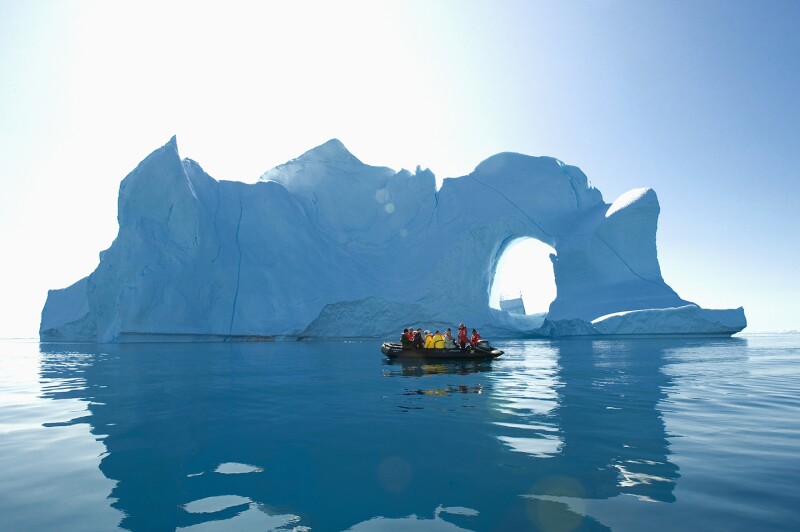It’s the rarest of celestial rendezvous: The dark silhouette of the moon completely obscures the fiery rays of the sun, causing an ephemeral moment of daytime darkness. A total solar eclipse only happens in any given place about once every 100 years and is said to be the experience of a lifetime. Yet to witness one on a boat at the end of the Earth in view of breaching whales and shifting ice floes surely takes that experience to another stratosphere entirely. That’s exactly what can happen on December 4 when a polar solar eclipse passes over a swath of the Southern Ocean for only the second time in the history of commercial visits to Antarctica, darkening the skies for nearly two minutes on a day of otherwise endless light.

The Lindblad Expeditions ship National Geographic Explorer at anchor off Peggotty Bluff, South Georgia, South Atlantic Ocean.
Photo by Michael S. Nolan
The eclipse will be extraordinary not only for its stark setting on the edge of the seventh continent, but also for the way it moves across the sky from east to west, a reversal only possible near the poles. (Most eclipse paths move from west to east.) In a fortuitous coincidence, the narrow ribbon of totality will pass over one of the most accessible parts of the region, just off the coast of South America. Since you can’t view it from mainland Patagonia—and there won’t be another event like it until 2057—trips are already selling out fast.
Most of the two-dozen eclipse cruises will depart from the southernmost city in the world: Ushuaia, Argentina. From there, they’ll follow a circuit to the bays of the Antarctic Peninsula and the busy shores of South Georgia Island, the so-called Galápagos of the Southern Ocean, which holds millions of macaroni, gentoo, chinstrap, and king penguins. In between, boats will converge in the path of totality near the tundra-carpeted South Orkney Islands, which lie about 375 miles northeast of Antarctica and remain uninhabited aside from a seasonal British base and year-round Argentinian one.

Quark Expeditions, West Point Island, Falkland Islands
Photo by Acacia Johnson
Many voyages will also cruise beneath the dramatic cliff-lined coasts of the Falkland Islands, which are known as much for their penguin, seal, and albatross populations as the 3,500 hardy humans who call them home.
These include Quark Expeditions’ 20-day sailing aboard the Ocean Diamond (from $16,995), which features talks led by retired NASA astrophysicist Fred Espenak, who goes by “Mr. Eclipse” after documenting his experiences with more than two dozen of them.
Lindblad Expeditions (24 days; from $25,890) is operating three separate odysseys on the Antarctica, South Georgia, and Falklands route with National Geographic photographers onboard to help amateurs hone their camera skills on snarling elephant seals and calving glaciers. On the big day of darkness, viewing locations will include an infinity-view hot tub and the first transparent “igloos” at sea.

Ponant offers explorations in the eastern Weddell Sea, Antarctica
Photo by Nathalie Michel
Ponant is offering a more daring journey aboard Le Commandant Charcot (15 days; from $18,860) into the rarely explored eastern Weddell Sea, where passengers can enjoy the eclipse atop floating slabs of ice. The journey also dips into the southerly Larsen Ice Shelf for views of some of the world’s largest tabletop icebergs (and a chance for some bone-numbing polar scuba diving!).
Hurtigruten is similarly running a slightly different route: in and out of Punta Arenas, Chile, via the foggy fjords of Patagonia. The 18-day trip aboard the new hybrid electric-powered MS Roald Amundsen (from $18,854) skirts Cape Horn in route to the Antarctic Peninsula, South Orkney, and Falkland Islands.
Intrepid’s more wallet-friendly two-week trip aboard Ocean Endeavour (from $11,995) will take in the Antarctic Peninsula as well as the offshore South Shetland and Elephant Islands, all after stopping at a special eclipse point in the western Weddell Sea. (Also worth noting: As the largest B Corp certified company in the travel space, Intrepid offsets the carbon of all its trips.)

Elephant Island, Antarctica
Photo by Rod Long/Unsplash
The most adventurous—and expensive—eclipse itinerary isn’t actually on a ship at all. TravelQuest’s Antarctic Expedition to Totality (12 days; from $39,800) will have exclusive access to the only private seasonally occupied camp within the path of totality, which lies on Union Glacier at 79° South. On November 29, it will fly around 60 eclipse-chasers from Punta Arenas out to the seldom-visited glacier for a week-long expedition filled with cross-country skiing, fat biking, and hikes deep into the heart of Antarctica. Because Union Glacier lies within the continent’s so-called good-weather band, which has less cloud cover than the Weddell Sea, the trip may offer the best chance for cerulean skies come eclipse day.
Also departing from Punta Arenas are several specially chartered LATAM jetliners, including the EFlight 2021-Sunrise flights (from $6,000 per row of three seats). Developed by Glenn Schneider, an astronomer with the University of Arizona, these high-altitude flights will soar above any cloud cover on a five-and-a-half-hour roundtrip adventure through the skies above the Weddell Sea. The only signs of life, of course, will be the expedition cruises plying the steely blue waters below.
>> Next: This Pacific Island Just Became the World’s First Dark Sky Nation











